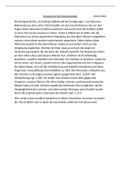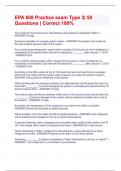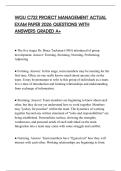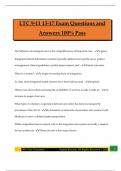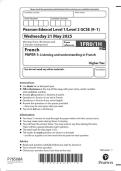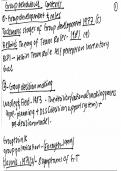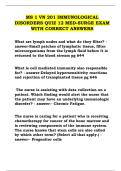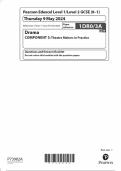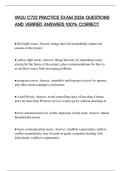1
Problem 1: Stress
➔ physical component: direct bodily change
➔ psychological component: how individuals perceive circumstances
➔ Three approaches to stress:
◆ stress as a stimulus– stressor: physically or psychologically challenging events
◆ stress as a response– strain: physical and psychological reactions to stressors
◆ stress as a process– transactions: continuous interactions and adjustments
between the person and the environment; includes stressors and strains
● stress is not seen just as a stimulus or a response, but rather a process in
which the person is an active agent who can influence the impact of a
stressor through behavioral, cognitive, and emotional strategies
● people differ in the amount of strain they experience from stressors
➔ Stress: the circumstance in which transactions lead a person to perceive a discrepancy
between the physical or psychological demands of a situation and the resources he/she
possesses
➔ these components might be real or just believed to exist by the individual
➔ components of the definition of stress:
◆ resources: biological, psychological and social resources for coping with difficult
events
◆ demands: the amount of resources the stressor requires
◆ discrepancy: mismatch between the demands of the situation-resources of the
person
● demands often exceed resources
● resources might also be underutilized: e.g. lack of challenge in
work/studies
● stress often results from inaccurate perceptions of discrepancies!
◆ transactions: assessing demands, resources, discrepancies etc.; influenced by
many factors e.g. prior experiences
➔ Cognitive appraisal:
◆ primary appraisal: when we face the first signs of a potentially stressful situation,
we first assess its meaning for our wellbeing
● can be classified as irrelevant, good (benign-positive) or stressful
, 2
● events classified as stressful go through further appraisal
○ harm-loss: amount of damage that has already occured from the
stressor
○ threat: expectation of future harm
○ challenge: the opportunity to achieve growth, mastery or profit
when using more resources to meet a demand
● appraisals also influence vicarious transactions, when we observe
stressful situations other people undergo
◆ secondary appraisal: assessment of the resources we have for coping, occur
continuously
◆ if we believe our resources can meet the demands– little to no stress
◆ factors leading to stressful appraisals:
● personal factors:
○ self-esteem: high self-esteem people believe that they have the
sufficient resources to meet demands and more likely to perceive
stressful events as challenges rather than threats
○ motivation: more important the goal, the more stress
○ belief system: some irrational beliefs increase stress; e.g.
appraising even minor inconveniences as major issues
● situational factors:
○ have strong demands
○ imminency
○ life transitions
○ difficult timing
○ ambiguity
○ low desirability
○ low controllability: behavioral and/or cognitive control
➔ Biopsychosocial aspects of stress:
◆ biological aspects
● reactivity: the physiological portion of strain
○ measured against a baseline level of arousal
○ influenced by genetics
○ people under chronic stress often show heightened reactivity &
take longer to return to baseline levels
● fight-or-flight response: by Cannon; perceived danger activates
sympathetic nervous system– can have positive and negative effects
, 3
● General adaptation syndrome (GAS) by Hans Selye:
1. Alarm reaction:
a. similar to fight or flight
b. mobilizes body’s resources
c. sympathetic nervous system activates many organs like
adrenal glands– release epinephrine & norepinephrine to
the bloodstream— further activation
d. hypothalamus-pituitary-adrenal axis (HPA) activated (less
quickly)
2. stage of resistance:
a. arousal remains high as body tries to adapt to the stressor
b. HPA activation dominates; reactions of the SNS becomes
less pronounced
c. there are few outward signs of stress, but body becomes
less able to resist new stressors
d. more vulnerable to diseases of adaptation; ulcers, high
blood pressure, asthma, impaired immune function
, 4
3. stage of exhaustion:
a. prolonged physiological arousal by repeated/long-term
stress weakens immune system
b. depletes energy reserves– damage to internal systems
● allostatic load:
○ accumulated effects on the body by having to adapt repeatedly to
stressors
○ high level is related to poor health
○ amount of exposure: more frequent, intense and prolonged
stressors= greater physiological activation
○ magnitude of reactivity: people differ in their levels of response
to any particular stressor
○ rate of recovery: people differ in returning to baseline levels of
activation after a stressor is over
○ resource restoration: resources used up by strain can be
replenished by various activities, most importantly sleep
● Selye believed that GAS is nonspecific to the type of stressor. However,
there are a few problems with this:
○ some stressors elicit stronger emotional reactions; and different
stressors can elicit different patterns of hormonal activation
○ physiological arousal depends on effort and distress:
◆ effort + distress: increased catecholamine and cortisol
◆ only effort: an active and content state; increased
catecholamine
◆ only distress: increased cortisol
○ cognitive appraisal processes: reactions depends on how we
perceive the situation
◆ psychosocial aspects of stress:
● cognition:
○ high levels of stress can interfere with memory & attention
○ thinking about past stressors/ worrying about future ones can
prolong the physiological stress response; even in the absence of
actual stressors= makes stress chronic
○ effective executive functioning can help manage stressful
situations; but stress can also disrupt executive functioning=
vicious cycle
Problem 1: Stress
➔ physical component: direct bodily change
➔ psychological component: how individuals perceive circumstances
➔ Three approaches to stress:
◆ stress as a stimulus– stressor: physically or psychologically challenging events
◆ stress as a response– strain: physical and psychological reactions to stressors
◆ stress as a process– transactions: continuous interactions and adjustments
between the person and the environment; includes stressors and strains
● stress is not seen just as a stimulus or a response, but rather a process in
which the person is an active agent who can influence the impact of a
stressor through behavioral, cognitive, and emotional strategies
● people differ in the amount of strain they experience from stressors
➔ Stress: the circumstance in which transactions lead a person to perceive a discrepancy
between the physical or psychological demands of a situation and the resources he/she
possesses
➔ these components might be real or just believed to exist by the individual
➔ components of the definition of stress:
◆ resources: biological, psychological and social resources for coping with difficult
events
◆ demands: the amount of resources the stressor requires
◆ discrepancy: mismatch between the demands of the situation-resources of the
person
● demands often exceed resources
● resources might also be underutilized: e.g. lack of challenge in
work/studies
● stress often results from inaccurate perceptions of discrepancies!
◆ transactions: assessing demands, resources, discrepancies etc.; influenced by
many factors e.g. prior experiences
➔ Cognitive appraisal:
◆ primary appraisal: when we face the first signs of a potentially stressful situation,
we first assess its meaning for our wellbeing
● can be classified as irrelevant, good (benign-positive) or stressful
, 2
● events classified as stressful go through further appraisal
○ harm-loss: amount of damage that has already occured from the
stressor
○ threat: expectation of future harm
○ challenge: the opportunity to achieve growth, mastery or profit
when using more resources to meet a demand
● appraisals also influence vicarious transactions, when we observe
stressful situations other people undergo
◆ secondary appraisal: assessment of the resources we have for coping, occur
continuously
◆ if we believe our resources can meet the demands– little to no stress
◆ factors leading to stressful appraisals:
● personal factors:
○ self-esteem: high self-esteem people believe that they have the
sufficient resources to meet demands and more likely to perceive
stressful events as challenges rather than threats
○ motivation: more important the goal, the more stress
○ belief system: some irrational beliefs increase stress; e.g.
appraising even minor inconveniences as major issues
● situational factors:
○ have strong demands
○ imminency
○ life transitions
○ difficult timing
○ ambiguity
○ low desirability
○ low controllability: behavioral and/or cognitive control
➔ Biopsychosocial aspects of stress:
◆ biological aspects
● reactivity: the physiological portion of strain
○ measured against a baseline level of arousal
○ influenced by genetics
○ people under chronic stress often show heightened reactivity &
take longer to return to baseline levels
● fight-or-flight response: by Cannon; perceived danger activates
sympathetic nervous system– can have positive and negative effects
, 3
● General adaptation syndrome (GAS) by Hans Selye:
1. Alarm reaction:
a. similar to fight or flight
b. mobilizes body’s resources
c. sympathetic nervous system activates many organs like
adrenal glands– release epinephrine & norepinephrine to
the bloodstream— further activation
d. hypothalamus-pituitary-adrenal axis (HPA) activated (less
quickly)
2. stage of resistance:
a. arousal remains high as body tries to adapt to the stressor
b. HPA activation dominates; reactions of the SNS becomes
less pronounced
c. there are few outward signs of stress, but body becomes
less able to resist new stressors
d. more vulnerable to diseases of adaptation; ulcers, high
blood pressure, asthma, impaired immune function
, 4
3. stage of exhaustion:
a. prolonged physiological arousal by repeated/long-term
stress weakens immune system
b. depletes energy reserves– damage to internal systems
● allostatic load:
○ accumulated effects on the body by having to adapt repeatedly to
stressors
○ high level is related to poor health
○ amount of exposure: more frequent, intense and prolonged
stressors= greater physiological activation
○ magnitude of reactivity: people differ in their levels of response
to any particular stressor
○ rate of recovery: people differ in returning to baseline levels of
activation after a stressor is over
○ resource restoration: resources used up by strain can be
replenished by various activities, most importantly sleep
● Selye believed that GAS is nonspecific to the type of stressor. However,
there are a few problems with this:
○ some stressors elicit stronger emotional reactions; and different
stressors can elicit different patterns of hormonal activation
○ physiological arousal depends on effort and distress:
◆ effort + distress: increased catecholamine and cortisol
◆ only effort: an active and content state; increased
catecholamine
◆ only distress: increased cortisol
○ cognitive appraisal processes: reactions depends on how we
perceive the situation
◆ psychosocial aspects of stress:
● cognition:
○ high levels of stress can interfere with memory & attention
○ thinking about past stressors/ worrying about future ones can
prolong the physiological stress response; even in the absence of
actual stressors= makes stress chronic
○ effective executive functioning can help manage stressful
situations; but stress can also disrupt executive functioning=
vicious cycle

